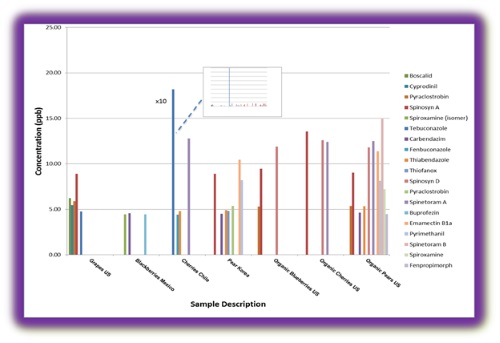As the saying goes, “You are what you eat”.
A high school student in the US recently took this saying to a whole new level, initiating a science project to test her favorite fruits for their pesticide content to really understand what she was actually eating.
Just like with this astute teenager, there is a growing consciousness and desire among Asians to lead healthier lifestyles.
This is evident in the popularity of fitness centers, gadgets and devices that track weight and distance walked, and overall decisions by consumers to make healthier food choices.
In Singapore, as I was told by my colleagues, a quick trip to the supermarket reveals “the less” trend, where packaged products are making claims of “less fat”, “less sodium” and similar.
Organic produce boom
However, consumers are becoming less fooled by these marketing claims and are seeking to purchase fresh, non-processed foods to try to eliminate processed chemicals from their diets altogether.
As a result, more shelves are now dedicated to organic fresh produce and products.
According to Market Research’s report titled Asia Pacific Organic Food and Beverages Industry Outlook to 2016, the demand for organic food products has grown at a compound annual growth rate of 12.4% from 2006-2011 in the region.
The demand is considerable in advanced and emerging markets such as Australia, China, Japan and India, with Japan contributing the largest share of revenue generated through the sales of organic food and beverages, followed by Australia, and China and India combined.
In the last two to three years, countries such as Malaysia, Singapore and Taiwan have seen tremendous growth in terms of organic food consumption due to the surging organic productivity observed locally.
The true organic
Despite such growth, many have asked, “Are organic or organically labeled foods actually better? Is it true that they are 100% free of pesticides or chemical contaminations?”
Local food and agri-products authorities define organic food as “foods which are produced based on farming and processing methods that avoid the use of chemicals such as artificial fertilizers and chemical pesticides”.
Conventional food products, on the contrary, are typically produced with the traditional way of farming and with less regulation on the level of pesticides and chemical fertilizers used to substantiate the volume of product they are demanded to produce.
However, due to the proliferation of organic food products in the market, the more skeptical consumers start to wonder if products labeled as “organic” are indeed 100% chemical contaminant or pesticides-free.
Defining “organic”
Currently, Singapore has yet to establish a widely recognized official set of organic food standards notwithstanding the food surveillance program that ensures safe food consumption.
This is perhaps due to the ambiguity around how organic food is defined.
According to the US Department of Agriculture (USDA), to be certified as organic, there are four definitions: 100% organic, organic (95%), made with organic ingredient (70%), or organic ingredient (70%).
Except for the first one, the remaining three labels give allowance to a certain level of chemicals contained in the food product.
As these four definitions indicate, organic food certifications cover a wide-scope of compositional definitions, and the exact wording on the label claims can again mean the difference between a 100% organic product and a product ‘made with organic ingredients’, which may only be comprised of 70% of organic ingredients.
It is this type of information that leads into our question posed above: Are the organic foods I’m consuming really 100% free of chemicals?
To get an answer, conduct a pesticide or chemical analysis to give consumers an unequivocal answer of what is in the food they are eating.
Pesticide testing on organic, inorganic food
Pesticides are used by farmers to reduce bugs, pests, fungi, molds and kill unwanted weeds.
When people consume food products that contain pesticides, it could lead to acute or chronic poisoning, exposing consumers to risk of cancer and infertility, and, in extreme cases, result in death.
Given that most consumers still typically buy conventionally-farmed products, although many will spend the extra money to invest in organic, it is of cardinal importance that all food products should undergo sample testing to ensure they fulfill a set of criteria for both food safety as well as consumer expectations.
Such testing is typically carried out in various stages before food products are served on the table.
It can occur anytime during farming, manufacturing, processing and transportation.
Since organic foods should contain very low levels of chemical contaminants and pesticides (or not contain any at all), a robust, powerful testing workflow could still detect the tiniest trace of chemicals that might be present in those food products.
As there is a multitude of different types of pesticides commonly used in food products, with a rough estimate of that number surpassing 1,000, their diversity in compound structures, polarities and sizes.
More than often, this makes analysis of these residues in food very challenging.
In some cases, more than one pesticide is used on a single crop, which demands a more powerful and faster approach to detect very low concentrations of large screens of pesticides in diverse sample matrices.
Regulations pertaining to pesticides vary in every region.
In Singapore, the Agri-Food & Veterinary Authority of Singapore is the official regulatory body whose laboratory is designated as the National Reference Centre for pesticide residue testing.
Some pesticide residues are allowed within a certain limit, known as the maximum residue limit (MRL).
However, some residues are zero-tolerance, so they are not approved for use at all and are not allowed if detected at any level.
Mass spectrometry analysis of pesticide residues in food
Traditionally, pesticide testing is done with various disparate methods, which are advantageous with limitations. In recent years, Liquid Chromatography (LC) coupled to tandem mass spectrometry (MS/MS), collectively known as LC/MS/MS, has been regarded as a better method for its ability to analyze a wider range of compounds in a single analysis.
This simplifies sample extraction procedures and streamlining sample preparation procedures, while offers scientists unmatched selectivity and sensitivity through the use of multiple reaction monitoring (MRM).
The steps outlined below illustrate how pesticide testing for organic food can be done using an LC/MS/MS workflow.
- First, food samples (organic or conventional) are collected, cut and blended.
- About 15 g of each homogenized food sample are then taken and mixed with 15 ml of a standard solution of 1% acetic acid in acetonitrile.
- The pesticide residues are then extracted from the food samples using a modified quick, easy, cheap, effective, rugged and safe (QuEChERS) procedure, a streamlined approach for pesticide residue testing.
This procedure is hailed as the one of the most used sample preparation techniques in food testing, saving time through use of generic sample preparation, allowing the extraction of more pesticide residues at once, making it highly suitable for large-scope screening.
- Depending on the sample type being analyzed, technicians sometimes choose to substantiate the QuEChERS preparation with an additional clean-up step; for instance, graphitized carbon black (GCB) may be added to remove pigments so samples that are red or pink in color become clearer; C18 may be used to remove lipids or other non-polar interferences.
In some cases where samples are much simpler, such as juice, clean-up is not needed at all.
- The extracts are then shaken and centrifuged then diluted up to five or ten times to help to eliminate any interference that might result from the food matrix on the analysis of the pesticides of interest.
- A highly sensitive and reliable mass spectrometer detection system is, therefore, essential to achieve sensitivity to detect any low level chemicals present but still allowing for sample dilution to reduce the volume of matrix interferences.
- After these sample preparation steps are completed, the sample is transferred to a vial for analysis.
- An LC/MS/MS system is then calibrated using a particular standard for pesticide testing and used to analyze the food product for pesticide content.
- This standard is also often used to assess batch quality control, where it is typically spiked into a clean food sample at 10 parts per billion or ppb (the lowest regulated level for many pesticide residues) to ensure that the results for the entire batch of food samples under analysis are accurate and reliable.
The chart above shows an analysis of pesticide residues detected in a number of organic versus conventional food products.
Even though the sample pears are labeled as organic, they actually contain several pesticides like Thiabendazole, a fungicide, and some of the pesticide levels in the organic pear sample even exceed those observed in the conventional pear sample.
To assist laboratories in pesticide quantitation (to determine exactly how much of a pesticide is there) and to help to ensure confidence in results (no false positive or false negative results are reported), pesticide compound libraries that include more than 600 full MS/MS spectra for commonly tested residues and metabolites and multiple reaction monitoring (MRM) for more than 550 compounds are available to make high-throughput screening easier to adopt for food testing labs.
Conclusion
In summary, with the aid of advanced technologies for food safety testing, confirming pesticide content and identifying pesticide types and levels for both organic and conventional foods is made simple and guarantees accurate results quickly.
As more organic foods are being consumed in the region, food manufacturers, resellers, and regulatory bodies will continue to uphold the responsibility to ensure and ascertain the organic food sold to the consumers are truly free of chemical pesticides before an organic label is applied or given.
Story by Lauryn Bailey, PhD, global marketing manager, food and environmental markets, AB SCIEX and Liesl Krone, Crossland 9th Grade Center.












